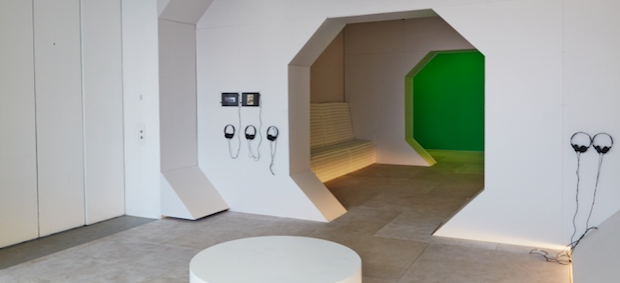“He who talks a lot always loses part of his mass.” Ironically, this line from a video by Zbynek Baladran is almost buried by the New Museum’s overloaded show Report on the Construction of a Spaceship Module. The show’s guest curators, tranzit, a network of mainly Eastern European art collectives, along with Lauren Cornell, ambitiously attempt to upend the Western capitalist narrative of art history, but also reach far beyond the limits of what’s reasonably possible in the New Museum’s small fifth floor space. With its stack of newspapers filled with artist bios, dozens of videos, scrolling exhibition histories, and shelves packed with artifact-like art objects, the show has the sleek curatorial look of the pseudo-encyclopedic info-binge popularized by star curators like Hans Ulrich-Obrist, Massimiliano Gioni, and Carolyn Christov-Bakargiev. The checklist hits on everything from Cold War science fiction to 1970s Mozambican revolution, and they’re not always connected by any clear line of thought. A project this grand needs more space.
While the show could use an editor, we do get to glean some choice historical nuggets in spaceship countdown video program; stay long enough, and you’ll get a lesson on cosmological avant-gardist Stano Filko; Tamas St. Turba’s Centaur, a biting 1973 documentary on Budapest factory workers talking about dead dreams; and Ruy Guerra’s Mueda, a 1979 community reenactment of a massacre which led to the Mozambican War of Independence. I can’t stop thinking about the possible riddle in the 1986 video of a man who’s introduced as the influential German philosopher Walter Benjamin, delivering a lecture on the meaning of art in the era of reproduction, as Walter Benjamin; the lecture was made 40 years after Benjamin’s death. Benjamin is known for his essay “The Work of Art in the Age of Mechanical Reproduction,” so the video seems like a tongue-in-cheek performance which none of the slouching art students understand. (It’s also funny).
Overall, the clearest thread between all the works is history, class struggle, and a hope for a better future, which seems like an especially timely historical revision. The videos are excellent, and given the sheer volume of footage, I wish the New Museum would simply compile them into a DVD.
That DVD could be used to solve another issue: I had to look up much of the historical background and context later, to better understand the work. That doesn’t bode well for the life of the show.
I suppose, though, that the morass of information could be seen as a call for Westerners to revise our straightforward ideals. Report on the Construction of a Spaceship Module presents Communism and failed ideologies in direct contrast to the confidence of consumer culture. Assuming that late capitalism poses a crisis for art, some major reassessing of our values will be necessary.
This idea is expressed beautifully in Zbynek Baladran’s video “The Microscope and the Telescope of Time“, a meditation on the linearity of art and history. As she flips through a stack of photographs, a female voice tells us about Lucretius Carus’s philosophy of art as a continuum of images, which are constantly broken apart and reformed to create new culture. “In our era, nothing remains other than to dissect the original meaning, pulverize it and impose new meaning on it,” she reflects. It’s a line that should resonate with anybody who’s been feeling that New York has become a polluted, vapid mess.
Oddly enough, though, it’s hard not to want a little more of that kind of dissection from the show. For an exhibition that seeks to rewrite history, the curators have managed to provide surprisingly little argument for it.




Comments on this entry are closed.